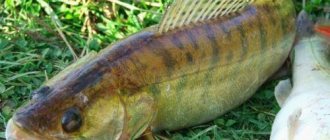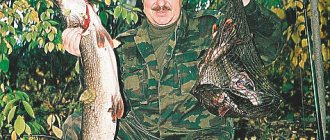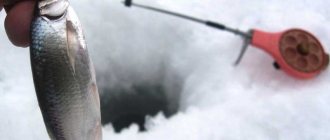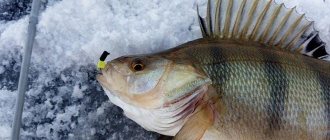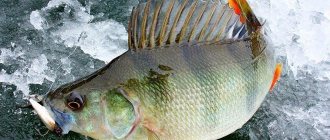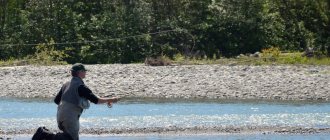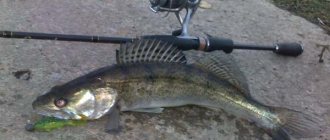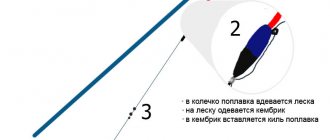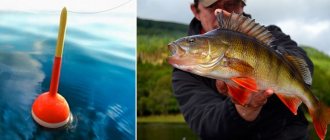At great depths in the absence of a current, vertical fishing can be a worthy competitor to such a popular method of fishing in the bottom layers as jig. Knowing the location of holes, channel edges and other deep-sea promising places (or using an echo sounder), you can quickly check such interesting places for the presence of an active predator. This method of fishing involves minimal movement of the bait in the horizontal plane, which means that vertical fishing is quite justified in snagged areas of the reservoir, as well as in places with abundant underwater vegetation. Also, many anglers are attracted by the low cost of gear - the simplest reels are suitable, and rods can even be made from broken spinning or feeder blanks.
Rod and reel
The popularity of the fishing method is not least due to the low cost of gear - the requirements for a rod and reel are minimal. Short winter and side rods are excellent, and a wide variety of homemade products are often used - hard feeder quivertips; what is left of a broken spinning rod or other rod can, with minimal modification, be used for vertical lures. How to make a plumb line and what to make it from is a matter of personal preference, but you can always buy ready-made fishing rods. On some bodies of water, when fishing from the shore, long (from 6 meters) rods can be used, but in most cases, vertical lures involve fishing from a floating device. For small boats, fishing rods 60-80 cm long are suitable; more than a meter will cause inconvenience, although on a large boat, a 2-meter spinning rod may well be suitable for vertical fishing. It is also advisable to install a nod on the rod for better bite control, although this is not necessary.
Photo 1. Compact fishing rod for vertical fishing.
Important!
When choosing a suitable fishing rod, you need to take into account, among other things, the size of the swimming device. There are also quite a lot of suitable reels. Ideally, the best option would be a multiplier reel, since significant depths often contain worthy specimens, which will be much easier to catch with the help of a powerful multiplier. However, such devices are not cheap, and many fans of sheer trolling use inertial reels made in the USSR, as well as inexpensive spinning reels. It is highly desirable that the reel allows the use of braided lines.
Pike perch baits for vertical fishing
Pike perch is a very picky fish, so you should be careful when choosing bait. When going fishing, it is better to have several types of bait with you, because the culinary preferences of fish are constantly changing.
Practice has shown that in this type of fishing, such as catching pike perch vertically from a boat, bait plays a major role. The design of the rod or the type of reel is not so important here, but the bait must irritate the predator and force itself to attack. Otherwise there will be no result.
The most common baits for this type of pike perch fishing are:
- live bait (including dead bait);
- heavy spinners of the "kas" type;
- heavy pike perch jig of the Uralka type;
- oscillating spoons;
- foam and silicone fish
Fishing line and bait
In this type of fishing, the use of both monofilament and braided lines is allowed. However, the cord is still preferable, since the low stretchability of the braided line when trolling vertically provides two significant advantages:
- The minimum stretchability of the braid allows you to maintain sufficient sensitivity of the gear even when fishing at great depths.
- In addition to making it easier to control the bait, the braided cord, due to its low elongation, makes hooking more efficient and comfortable.
Also, do not forget about the greater tensile strength of the cords.
A wide variety of baits are used for fishing, however, these are primarily different variants of spinners. There are a large number of different models in use:
- Summer oscillating spoons.
- Almost all varieties of winter lures, including those with balancers (in fact, vertical lures are the same as winter fishing, only in open water).
- Offshore jigs.
- Tubular spoons and castmaster models.
Photo 2. Castmasters often use it for vertical fishing. - Various silicone baits.
- Wobblers with a “rattlin” body shape.
Perch at shallow depths
For catching perch at shallow depths, vertical perch lures are very effective at this time. Here, at medium and shallow depths, perch is often caught very well with small twisters. The technique of the game is very simple and consists only of raising the bait and lowering it down to the bottom. At the same time, twisters play very actively with their large “tails”. In a good perch spot and at the right time, this type of fishing can be very successful, especially if a catchable bait is found experimentally. Often it is small twisters and or silicone worms that bring good luck in the form of medium and fairly large perches.
Optional equipment
Considering that many anglers often fish in unfamiliar bodies of water, and vertical fishing is most effective at great depths and various holes, the need for accurate knowledge of the features of the bottom topography becomes clear. With sufficient fishing experience in a particular body of water, it is quite possible to find your way without additional technical equipment, but unfamiliar places make the presence of an echo sounder a necessary condition for successful fishing using vertical lures.
Attention! It is very convenient if the echo sounder has a built-in navigator - with it you will be able to take the necessary position for successful fishing much faster.
When using an echo sounder, it is advisable to focus not only on the features of the relief, but also on the fish displayed by the device - if the device detects a large accumulation of fish near a hole, then these are most likely peaceful species, but single marks on the screen next to such groups are most likely predators.
Features of tactics
Since this type of fishing is aimed at great depths, it is not advisable to use vertical lures at depths of less than 3 meters - large predators are quite cautious and will be suspicious of the shadow of a boat. In reservoirs, it is better to immediately look for differences in depth and purposefully fish for them, using the wind or current to move slowly along the promising area. If the wind or current is too strong, it is necessary to use various options for braking anchors or so-called water sails. It is important to remember that the angle at which the fishing line or cord departs from the swimming device should approach 90 degrees; sharp angles are not suitable for vertical fishing, as the action of the bait deteriorates and the likelihood of a snag increases.
The tactics on lowland rivers are somewhat different. Their bed can also often be quite deep, but obvious differences in depth are rare. In such conditions, a zigzag trajectory of the boat with the catching of the encountered concentrations of fish would be appropriate.
How to catch pike perch from a boat in a vertical line?
The fishing technique in this way is very simple:
- After the boat is above the place where the predator is feeding, the craft is placed with its side facing the wave and a spoon is cast from the opposite side.
- After the spoon reaches the bottom of the reservoir , a sharp swing of the rod is made, followed by freely lowering the bait to the bottom.
- As soon as the spoon is completely lowered , a sharp swing of the rod is made again. Thus, a large expanse of water is fished, since the boat is not anchored, but slowly drifts across the reservoir.
The gear for this method of fishing is quite simple and can be made independently at home.
Rules for choosing:
- If you use store-bought fishing rods , then you can purchase the shortest stick, no more than 1 meter long. Pike perch is not too fond of large baits, so the rod test can be only 20 g.
- The reel, also chosen without “bells and whistles”, copes with its function very well; a small inertial reel, although inertia-free, at a slightly higher cost, is successfully used for this method of catching pike perch.
- The fishing line must have a diameter of at least 0.4 mm. If the fishing line is chosen thinner, then the play of the bait at depth, with a vertical lure, is not so attractive for this fish.
The bait for hunting pike perch in this way is a vertical spoon, which, when lowered to the bottom and then rises, plays in the water column, thereby resembling a small fish that pike perch feeds on. To catch this fish, small spoons with a length of 50–70 mm are used.
Suitable conditions for fishing
Sheer trolling is not effective at all times of the year. This is due to the fact that such fishing assumes that the fish are in the bottom layers of the reservoir. Good conditions for vertical trolling develop in the fall, when the water has already cooled down, and in the spring, while the reservoir has not yet warmed up. The best time for fishing coincides with the spring ban, but not all bodies of water (or areas of water bodies) are subject to this ban. Fishing outside the spawning grounds is quite possible, the main thing is not to use various poaching gear.
Plumb trolling of different types of fish
Despite the common features, catching different types of fish using this method has its own distinctive characteristics. Catching pike vertically is quite similar to fishing for pike perch. They use the same fairly large baits, which have a fairly wide and low-amplitude game. Pike wiring is also somewhat different - if for pike perch you usually twitch the rod frequently, then for pike it is believed that a calmer wiring is suitable - with more uniform oscillations and long stops.
Photo 3. Fishing vertically is akin to winter trolling.
Catching perch vertically involves the use of much smaller baits than in the case of pike perch or pike perch. There are also differences in the fishing technique - the perch is more interested in short strokes and lifting of the bait, the play of which is enlivened by the trembling of the rod tip. Such movements can be alternated with sharp strokes, and you can start fishing from the middle horizons of the reservoir. It should be remembered that the higher the water temperature, the higher the chance of meeting perch at medium depths.
Fishing in the summer with a jig in a plumb line
> How to fish > Other fishing methods > Fishing in the summer with a vertical jig
Fishing methods, as well as the gear used to catch fish in the summer, are very diverse, it all depends on the preferences of the fisherman and the reservoir where fishing takes place.
One of these methods that few anglers resort to is fishing in the summer in a plumb line
.
In principle, the main purpose of vertical fishing is to deliver the bait right under the fish’s nose. In some situations, this may be the only way in the absence of a bite when an angler saves his fishing.
Fishing this way is best on small and medium-sized rivers near steep banks due to bushes and shelters. The prey most often is large roach, perch, chub, and rudd.
On lakes, you can also catch perch and large roach from steep banks and from bushes.
Large crucian carp, carp, are caught in this way in lakes and bays, choosing windows among water lilies and algae. Mostly fishing occurs from behind shelters from the shore; in some cases, you can fish vertically from a boat if you manage to approach the fish carefully. Plumb fishing with jig tackle
in the summer
is mainly intended for fishing in hard-to-reach places where other gear simply cannot be used.
What is the tackle for vertical jig fishing? First of all, this is a telescopic rod measuring 4-5 m, with a small spinning reel and rings. The rod should be light and durable like Flagman or DAM.
The main purpose of the rings is to quickly change the descent of the fishing line. The reel mainly serves as a fishing line storage and is practically not used for fishing. After all, there are a lot of bushes around, thick grass, snags, and if too large a fish gets on the hook, it will still drag the bait into the snag or immediately break off the equipment and no reel brake will help the matter. There is simply nowhere to let the line go.
A very important element of the equipment is the nod. The nod can be made of a variety of materials, thick fishing line, steel spring, cambric and the like. The nod should be brightly colored so that the bite can be seen even in the shadows or at dusk. If the fishing area is mainly biting by large fish, carp, chub or perch, then you can completely do without a nod. In this case, bites are detected by the soft tip of the fishing rod.
As for the fishing line, it should be thin and inconspicuous from 0.15 to 0.20, depending on what kind of fish you will be fishing for. If vertical fishing is intended for roach or rudd, you need to use a thinner line, if for carp or chub a thicker one.
Fishing line with fluorocarbon coating also performs well. As for the leash, it is better not to use it when fishing vertically; the fewer different knots, the more reliable the tackle. It also scares the fish less.
Now about jigs, for summer vertical trolling jigs are quite different from winter jigs. Jigs for fishing in summer are quite large with a large hook. To catch roach and other small whitefish, use a jig weighing 1-1.5 g, with hooks No. 3.5-4 according to our classification. If you intend to catch carp, carp, large crucian carp or chub, larger jigs weighing 2.5-4 grams are used. Hooks, as a rule, have size No. 5-6.
In addition, the appearance of a summer jig is not as important as a winter jig. Here the main role is played by bait or attachment. For carp fish, primarily for crucian carp, carp, roach and chub, it is better that the jigs are as inconspicuous as possible without glare, that is, inconspicuous is better than dark brown or black. For catching perch, it is recommended to use shiny jigs. In terms of shape, it is preferable to use pellet, drop, or ant jigs. A simple pellet clamped right next to the hook will work perfectly. But it’s still better to use jigs that have a small angle of inclination of the hook tip relative to the fishing line.
Plumb fishing in summer
will be successful if you choose the right bait at a given time and in a given body of water. This could be a grasshopper, a cockchafer, a worm, a mayfly, a fly, etc. It is especially good if you use clusters of bloodworms, caddis flies, and bark beetle larvae.
The technique of vertical fishing is completely simple, but it requires constant creative exploration. You need to carefully approach a clearing between reeds or coastal bushes or a window among algae and water lilies and lower the jig with bait into the intended place. You also need to select the desired game with a jig, with long or short pauses, slow smooth raising and lowering, sometimes increasing the speed of its movement, etc. Also, depending on the conditions of the reservoir and the type of fish, you can play with a jig at the bottom or in the middle of the water. You can play with the bait at the surface of the water or simply bounce the jig in the water. That is,
vertical
fishing in the summer requires bold experiments.
An integral part of fishing with a summer jig is reliable camouflage. First of all, you should behave as quietly as possible; you should approach the place of intended fishing very secretly, trying not to outline your outline in the field of view of the fish in the water. You should also not make sudden movements and wear clothes similar in color to the surrounding vegetation. In this case, camouflage would be ideal.
When fishing is carried out from a rubber boat, since boats made of other materials are not suitable (too noisy), you need to swim smoothly and silently to the intended fishing spot, but from a boat it is still very difficult to deceive a cautious fish. It’s still better to fish vertically from the shore from behind the bushes.
The best results for vertical fishing occur in the spring. At this time, the fish, as a rule, is hungry and does not pick and choose, which means there is no need to come up with any tricks for playing with a jig. As soon as the bait appears near the prey, a bite immediately follows.
With the arrival of summer, everything changes, the water becomes clearer, and the fish are more well-fed and very careful. Sometimes, in order not to give yourself away and to reach the right place, you have to resort to longer rods 6-7 meters long.
Some anglers catch fish such as crucian carp in a wade, carefully making their way in waders or wading boots to the fishing spot.
Of course, vertical fishing in the summer
requires a significant expenditure of energy, however, it is not only interesting but can provide an experienced fisherman with an excellent catch.
Published: 07/04/2015
Other interesting materials:
| Armchairs and chairs for fishing An armchair or chair for fishing is a necessary attribute, because often a fisherman… | Today we will talk about fishing in the spring of March. This month there are many sunny days, the air temperature... | What kind of fish lives in Indigirka? Mother Siberia is great and vast! Its vast expanses are covered with dense... | The subtleties of catching grayling with a jig A lot is known about grayling and fishing for this beauty is very popular... |
